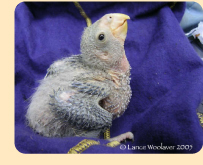 |
|||
|
|
|||
|
 What Species: Hispaniolan Parrot (Amazona ventralis) What Species: Hispaniolan Parrot (Amazona ventralis)
Where: Pedernales Province and the Sierra de Bahoruco National Park, Dominican Republic. Who: Sociedad Ornitológica de la Hispaniola with Dr. Steven Latta (National Aviary) and Dr. Todd Katzner (National Aviary), in collaboration with the Animal Programs Department at the National Aviary and Natural Encounters, Inc. When: 2005 – present Why: The Hispaniolan Parrot is found only on the island of Hispaniola, made up of the Dominican Republic and Haiti. The species, considered vulnerable to extinction by BirdLife International, is under serious threat by the pet trade. Today the Hispaniolan Parrot is still locally common only in major forest reserves such as Parque del Este, Jaragua National Park, Sierra de Bahoruco National Park, and the twin parks of the Cordillera Central, Armando Bermúdez and José del Carmen Ramirez national parks. Parrot populations have declined alarmingly; for example, there was at least a 95% decline in parrot numbers in Los Haitises National Park, DR, from 1976 to 1996. Traditional Dominican and Haitian practices of keeping caged parrots as pets continues to create a strong demand for parrot chicks every breeding season. Parrot chick poachers annually search montane areas in the Sierra de Bahoruco and Cordillera Central for nests, most often found in very old trees, and destroy these natural nesting cavities to extract the nestlings. Not only do these poachers remove parrot chicks from the population, they also render these cavities useless for further nesting by other parrots, or other threatened, endemic cavity nesters. Current Goals: In 2006, the Sociedad Ornitológica de la Hispaniola, with support from the National Aviary, initiated an innovative pilot campaign to help conserve remaining populations of the Hispaniolan Parrot in the Sierra de Bahoruco. The project has two major components: Educational Outreach, and Research and Monitoring. Each component has its own set of objectives and activities organized as follows: Educational Outreach
Page 2 
|



 Involve and build capacity of local communities in Hispaniolan Parrot conservation and habitat stewardship, through educational outreach and field training of school students.
Involve and build capacity of local communities in Hispaniolan Parrot conservation and habitat stewardship, through educational outreach and field training of school students. 